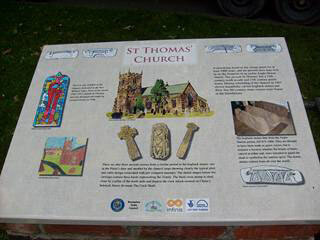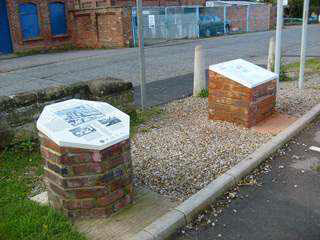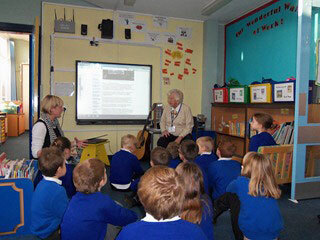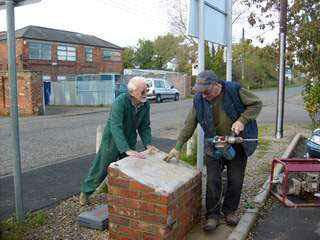In 2011 Brompton Heritage Group was awarded Heritage Lottery funding in order to provide three interpretive boards (story boards) for the village. The subjects had already been chosen because of their historical significance for Brompton and beyond.
The first of these boards refers back to the late pre-Conquest years when the Anglo-Saxon stone hogback grave covers and wheel head crosses, now in Saint Thomas’ Church, were carved. These are internationally famous, drawing visitors from all round the world. This storyboard, giving information on the present church, which would have replaced the original, probably wooden, building, and the story of how the stones were discovered, can be seen on Church Green, slightly to the left of the Lych Gate.


Another important event was the Battle of the Standard in 1138, when the English army successfully defeated the Scots on the edge of the village on what is now known as Standard Hill.
The third and much more recent event, which has done much to shape the nature and character of Brompton, was the establishing of the two linen mills here in the mid 1800’s. These survived into living memory, the last one closing in the late 1950’s. These last two storyboards can be found on the edge of Brompton Recreation Association car park, standing side by side opposite the remaining buildings of the mills.
Part of the remit for the lottery funding was that the children of Brompton Primary School should be involved in the production of the information shown on the boards. The school rose to the occasion with enthusiasm, holding a Brompton Heritage Day in November 2011, when the usual curriculum was put to one side while every child learnt about the history of the village. Mrs Vera Brittain, who had worked as a weaver in Yeoman’s Mill for six years after the end of World War II, went into the school for the whole day to talk to every class and to answer questions on her experiences. She was ninety years old at that time.
Some of the children’s work had already been started and much of it was continued afterwards, making a wonderful display of written and art work. Of course, only a few of the pieces could be used on the storyboards because of the lack of space, but the full body of the work was put on display in the school hall.

Meanwhile, decisions had to be made about the stands, or plinths, for the boards to be fastened into. It was agreed that members of the Committee should build these out of the bricks remaining from the demolition of the last mill chimney in 2003. This chimney had been octagonal, and there were enough of the shaped bricks left for the stand for the linen mill storyboard to be built as an octagon, to echo its shape.
The other two stands are rectangular. Final designs for the boards themselves were produced by members of a sub–committee with the assistance of SS Crome Associates, who also arranged for their manufacture.
Finally, on Friday 18th January 2013 Brompton Heritage Group held a celebration of the end of the project. Peter Walker (a.k.a. Nicholas Rhea the writer) had agreed to be the celebrity guest, but unfortunately was unable to attend because of ill health. Nevertheless, despite this disappointment a very successful event was enjoyed by guests and a group of children from the school.
The school choir entertained everyone with song and light refreshments were served.
Brompton Heritage Group, February 2013
